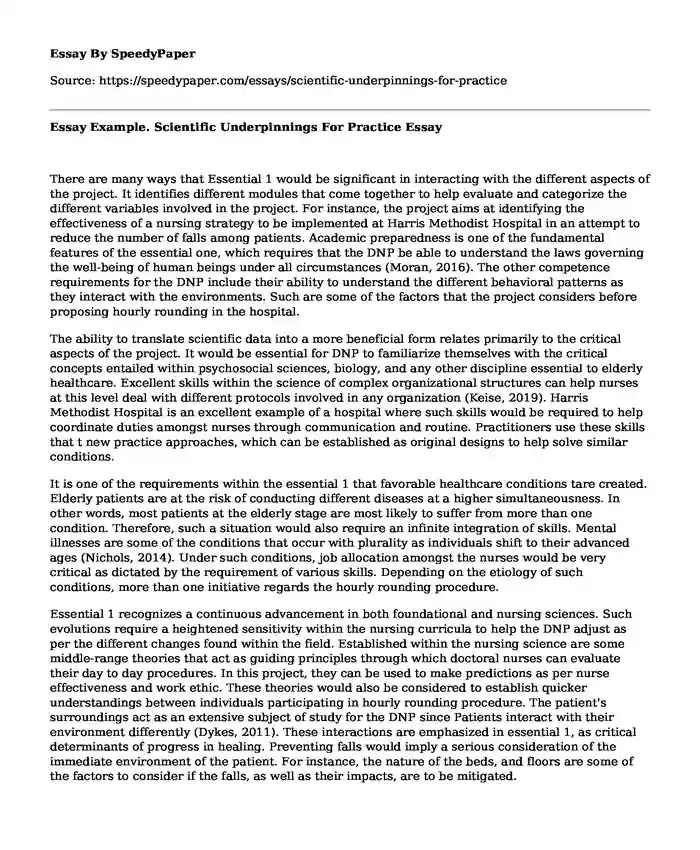
| Type of paper: | Course work |
| Categories: | Knowledge Nursing care Special education |
| Pages: | 3 |
| Wordcount: | 655 words |
There are many ways that Essential 1 would be significant in interacting with the different aspects of the project. It identifies different modules that come together to help evaluate and categorize the different variables involved in the project. For instance, the project aims at identifying the effectiveness of a nursing strategy to be implemented at Harris Methodist Hospital in an attempt to reduce the number of falls among patients. Academic preparedness is one of the fundamental features of the essential one, which requires that the DNP be able to understand the laws governing the well-being of human beings under all circumstances (Moran, 2016). The other competence requirements for the DNP include their ability to understand the different behavioral patterns as they interact with the environments. Such are some of the factors that the project considers before proposing hourly rounding in the hospital.
The ability to translate scientific data into a more beneficial form relates primarily to the critical aspects of the project. It would be essential for DNP to familiarize themselves with the critical concepts entailed within psychosocial sciences, biology, and any other discipline essential to elderly healthcare. Excellent skills within the science of complex organizational structures can help nurses at this level deal with different protocols involved in any organization (Keise, 2019). Harris Methodist Hospital is an excellent example of a hospital where such skills would be required to help coordinate duties amongst nurses through communication and routine. Practitioners use these skills that t new practice approaches, which can be established as original designs to help solve similar conditions.
It is one of the requirements within the essential 1 that favorable healthcare conditions tare created. Elderly patients are at the risk of conducting different diseases at a higher simultaneousness. In other words, most patients at the elderly stage are most likely to suffer from more than one condition. Therefore, such a situation would also require an infinite integration of skills. Mental illnesses are some of the conditions that occur with plurality as individuals shift to their advanced ages (Nichols, 2014). Under such conditions, job allocation amongst the nurses would be very critical as dictated by the requirement of various skills. Depending on the etiology of such conditions, more than one initiative regards the hourly rounding procedure.
Essential 1 recognizes a continuous advancement in both foundational and nursing sciences. Such evolutions require a heightened sensitivity within the nursing curricula to help the DNP adjust as per the different changes found within the field. Established within the nursing science are some middle-range theories that act as guiding principles through which doctoral nurses can evaluate their day to day procedures. In this project, they can be used to make predictions as per nurse effectiveness and work ethic. These theories would also be considered to establish quicker understandings between individuals participating in hourly rounding procedure. The patient's surroundings act as an extensive subject of study for the DNP since Patients interact with their environment differently (Dykes, 2011). These interactions are emphasized in essential 1, as critical determinants of progress in healing. Preventing falls would imply a serious consideration of the immediate environment of the patient. For instance, the nature of the beds, and floors are some of the factors to consider if the falls, as well as their impacts, are to be mitigated.
References
American Association of Colleges of Nursing, & American Association of Colleges of Nursing. (2006). The Essentials of doctoral education for advanced nursing practice.
Dykes, P. C., Carroll, D., McColgan, K., Hurley, A. C., Lipsitz, S. R., Colombo, L., Middleton, B. (2011). Scales for assessing self-efficacy of nurses and assistants for preventing falls. Journal of advanced nursing, 67(2), 438-449.
Keise, K. (2019). Preventing Falls in Long-Term Care Facilities (Doctoral dissertation, Walden University).
Moran, K. J., Burson, R., & Conrad, D. (Eds.). (2016). The doctor of nursing practice scholarly project. Jones & Bartlett Publishers.
Nichols, C., O'Connor, N., & Dunn, D. (2014). Exploring early and future use of DNP-prepared nurses within healthcare organizations. JONA: The Journal of Nursing Administration, 44(2), 74-78.
Cite this page
Essay Example. Scientific Underpinnings For Practice. (2023, Apr 08). Retrieved from https://speedypaper.com/essays/scientific-underpinnings-for-practice
Request Removal
If you are the original author of this essay and no longer wish to have it published on the SpeedyPaper website, please click below to request its removal:
- Free Essay Describing Relationship Between Therapist and Client
- Free Essay Sample on Cultural Imperialism
- Ecological Issues in This Free Essay Example
- Essay Sample on the Play Fences: Significance of the Title Fences
- HRM Essay Example on Performance and Compensation
- Essay Example Dedicated to the Age of Enlightenment: Reason and the Reformation of Society
- Essay Sample on Empowering Women Surfers: Dealing with Inequality and Discrimination
Popular categories




